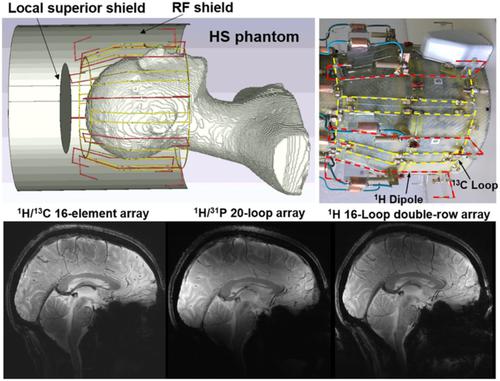当前位置:
X-MOL 学术
›
NMR Biomed.
›
论文详情
Our official English website, www.x-mol.net, welcomes your
feedback! (Note: you will need to create a separate account there.)
9.4 T double-tuned 13C/1H human head array using a combination of surface loops and dipole antennas
NMR in Biomedicine ( IF 2.7 ) Pub Date : 2021-06-24 , DOI: 10.1002/nbm.4577 Nikolai I Avdievich 1 , Georgiy Solomakha 2 , Loreen Ruhm 1 , Anke Henning 1, 3 , Klaus Scheffler 1, 4
NMR in Biomedicine ( IF 2.7 ) Pub Date : 2021-06-24 , DOI: 10.1002/nbm.4577 Nikolai I Avdievich 1 , Georgiy Solomakha 2 , Loreen Ruhm 1 , Anke Henning 1, 3 , Klaus Scheffler 1, 4
Affiliation

|
MRI at ultra-high field (UHF, ≥7 T) provides a natural strategy for improving the quality of X-nucleus magnetic resonance spectroscopy and imaging due to the intrinsic benefit of increased signal-to-noise ratio. Considering that RF coils require both local transmission and reception at UHF, the designs of double-tuned coils, which often consist of several layers of transmit and receive resonant elements, become quite complex. A few years ago, a new type of RF coil, ie a dipole antenna, was developed and used for human body and head imaging at UHF. Due to the mechanical and electrical simplicity of dipole antennas, combining an X-nucleus surface loop array with 1H dipoles can substantially simplify the design of a double-tuned UHF human head array coil. Recently, we developed a novel bent folded-end dipole transceiver array for human head imaging at 9.4 T. The new eight-element dipole array demonstrated full brain coverage, and transmit efficiency comparable to that of the substantially more complex 16-element surface loop array. In this work, we developed, constructed and evaluated a double-tuned 13C/1H human head 9.4 T array consisting of eight 13C transceiver surface loops and eight 1H transceiver bent folded-end dipole antennas all placed in a single layer. We showed that interaction between loops and dipoles can be minimized by placing four 1H traps into each 13C loop. The presented double-tuned RF array coil substantially simplifies the design as compared with the common double-tuned surface loop arrays. At the same time, the coil demonstrated an improved 1H longitudinal coverage and good transmit efficiency.
中文翻译:

9.4T双调谐13C/1H人头阵列,使用表面环和偶极天线的组合
由于信噪比增加的内在优势,超高场(UHF,≥7 T)的 MRI 为提高 X 核磁共振波谱和成像质量提供了一种自然策略。考虑到射频线圈需要在 UHF 下进行本地传输和接收,双调谐线圈的设计(通常由几层发射和接收谐振元件组成)变得相当复杂。几年前,一种新型的射频线圈,即偶极天线被开发出来,用于超高频的人体和头部成像。由于偶极天线的机械和电气简单性,将 X 核表面环形阵列与1H 偶极子可以大大简化双调谐 UHF 人体头部阵列线圈的设计。最近,我们开发了一种新型弯曲折叠端偶极子收发器阵列,用于在 9.4 T 下进行人体头部成像。新的八元偶极子阵列展示了全脑覆盖,并且传输效率与复杂得多的 16 元表面环形阵列相当. 在这项工作中,我们开发、构建和评估了一个双调谐13 C/ 1 H 人头 9.4 T 阵列,该阵列由八个13 C 收发器表面环和八个1 H 收发器弯曲折叠端偶极子天线组成,所有这些天线都放置在单层中。我们表明,可以通过在每个陷阱中放置四个1 H 陷阱来最小化环和偶极子之间的相互作用13 C 循环。与常见的双调谐表面环路阵列相比,所提出的双调谐射频阵列线圈大大简化了设计。同时,该线圈表现出改进的1 H纵向覆盖和良好的传输效率。
更新日期:2021-06-24
中文翻译:

9.4T双调谐13C/1H人头阵列,使用表面环和偶极天线的组合
由于信噪比增加的内在优势,超高场(UHF,≥7 T)的 MRI 为提高 X 核磁共振波谱和成像质量提供了一种自然策略。考虑到射频线圈需要在 UHF 下进行本地传输和接收,双调谐线圈的设计(通常由几层发射和接收谐振元件组成)变得相当复杂。几年前,一种新型的射频线圈,即偶极天线被开发出来,用于超高频的人体和头部成像。由于偶极天线的机械和电气简单性,将 X 核表面环形阵列与1H 偶极子可以大大简化双调谐 UHF 人体头部阵列线圈的设计。最近,我们开发了一种新型弯曲折叠端偶极子收发器阵列,用于在 9.4 T 下进行人体头部成像。新的八元偶极子阵列展示了全脑覆盖,并且传输效率与复杂得多的 16 元表面环形阵列相当. 在这项工作中,我们开发、构建和评估了一个双调谐13 C/ 1 H 人头 9.4 T 阵列,该阵列由八个13 C 收发器表面环和八个1 H 收发器弯曲折叠端偶极子天线组成,所有这些天线都放置在单层中。我们表明,可以通过在每个陷阱中放置四个1 H 陷阱来最小化环和偶极子之间的相互作用13 C 循环。与常见的双调谐表面环路阵列相比,所提出的双调谐射频阵列线圈大大简化了设计。同时,该线圈表现出改进的1 H纵向覆盖和良好的传输效率。











































 京公网安备 11010802027423号
京公网安备 11010802027423号